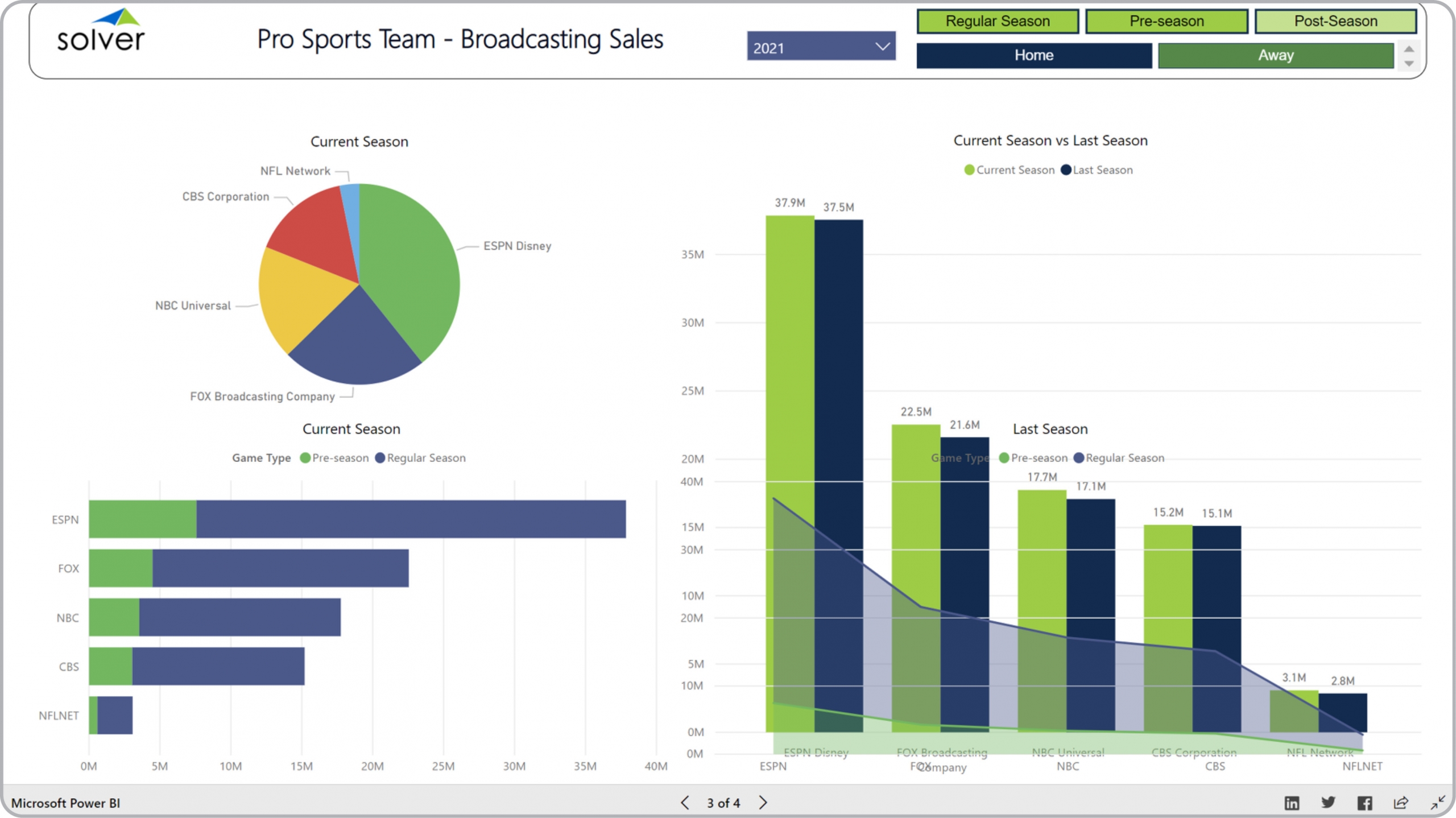Broadcasting Sales Dashboard for Professional Sports Organizations
What is a
Broadcasting Sales Dashboard
? Broadcasting Sales Dashboards are considered media revenue analysis tools and are used by CFOs and Sales Executives to track sales by broadcaster as well as total broadcast revenues. Some of the main functionality in this type of dashboard is that it provides analysis from three different perspectives: 1) Current season sales by broadcaster, 2) Regular versus pre-season sales - ranked by broadcaster, 3) Current season versus last season sales - ranked by broadcaster. Using the filters on the top of the screen, the user can filter by year, regular season/pre-season/Post-season as well as Home/Away games. You find an example of this type of dashboard below.
Purpose of
Broadcasting Sales Dashboards Professional sports organizations use Broadcasting Sales Dashboards to easily understand and compare the revenues they get from different broadcast partners. When used as part of good business practices in Financial Planning & Analysis (FP&A) and Sales departments, an organization can improve its revenues and related media partner strategies, and it can reduce the chances that any broadcast sales issues goes undetected for longer than necessary.
Example of a
Broadcasting Sales Dashboard Here is an example of a Broadcast Sales Dashboard with comparison and ranking of revenue from each company. [caption id="" align="alignnone" width="2560"]
 Example of a Broadcasting Sales Dashboard for Professional Sports Organizations[/caption] You can find hundreds of additional examples
here
Who Uses This Type of
Dashboard
? The typical users of this type of dashboard are: Team owners, executives, CFOs, Sales Managers, Media Managers.
Other Reports Often Used in Conjunction with
Broadcasting Sales Dashboards Progressive Financial Planning & Analysis (FP&A) and Sales departments sometimes use several different Broadcasting Sales Dashboards, along with profit & loss reports, annual budgets, sales forecasts, revenue dashboards, detailed broadcast sales reports and other management and control tools.
Where Does the Data for Analysis Originate From? The Actual (historical transactions) data typically comes from enterprise resource planning (ERP) systems like: Microsoft Dynamics 365 (D365) Finance, Microsoft Dynamics 365 Business Central (D365 BC), Microsoft Dynamics AX, Microsoft Dynamics NAV, Microsoft Dynamics GP, Microsoft Dynamics SL, Sage Intacct, Sage 100, Sage 300, Sage 500, Sage X3, SAP Business One, SAP ByDesign, Acumatica, Netsuite and others. In analyses where budgets or forecasts are used, the planning data most often originates from in-house Excel spreadsheet models or from professional corporate performance management (CPM/EPM) solutions.
What Tools are Typically used for Reporting, Planning and Dashboards? Examples of business software used with the data and ERPs mentioned above are:
Example of a Broadcasting Sales Dashboard for Professional Sports Organizations[/caption] You can find hundreds of additional examples
here
Who Uses This Type of
Dashboard
? The typical users of this type of dashboard are: Team owners, executives, CFOs, Sales Managers, Media Managers.
Other Reports Often Used in Conjunction with
Broadcasting Sales Dashboards Progressive Financial Planning & Analysis (FP&A) and Sales departments sometimes use several different Broadcasting Sales Dashboards, along with profit & loss reports, annual budgets, sales forecasts, revenue dashboards, detailed broadcast sales reports and other management and control tools.
Where Does the Data for Analysis Originate From? The Actual (historical transactions) data typically comes from enterprise resource planning (ERP) systems like: Microsoft Dynamics 365 (D365) Finance, Microsoft Dynamics 365 Business Central (D365 BC), Microsoft Dynamics AX, Microsoft Dynamics NAV, Microsoft Dynamics GP, Microsoft Dynamics SL, Sage Intacct, Sage 100, Sage 300, Sage 500, Sage X3, SAP Business One, SAP ByDesign, Acumatica, Netsuite and others. In analyses where budgets or forecasts are used, the planning data most often originates from in-house Excel spreadsheet models or from professional corporate performance management (CPM/EPM) solutions.
What Tools are Typically used for Reporting, Planning and Dashboards? Examples of business software used with the data and ERPs mentioned above are:
- Native ERP report writers and query tools
- Spreadsheets (for example Microsoft Excel)
- Corporate Performance Management (CPM) tools (for example Solver)
- Dashboards (for example Microsoft Power BI and Tableau)
Corporate Performance Management (CPM) Cloud Solutions and More Examples
April 25, 2021
TAGS:
Reporting,
Solver,
season,
sports dashboard,
network,
report writer,
Microsoft,
broadcast revenue dashboard,
template,
practice,
Acumatica,
visualization,
Netsuite,
Finance,
planning,
GP,
dashboard,
Business Central,
excel,
ax,
Sports,
forecast,
Budget,
pro sports,
Dynamics 365,
budgeting,
professional sports,
revenue,
Cloud,
Software,
Tableau,
SAP,
example,
best,
Sage,
BC,
D365,
NAV,
broadcast sales,
Intacct,
broadcast,
CPM,
report,
SL,
Management,
dynamics,
sales,
Power BI

